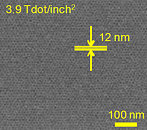Friday, November 26th 2010

Hitachi and Partners Develop New HDD Technology Providing 8-Fold Density Increase
A consortium led by Hitachi, including Japan's New Energy and Industrial Technology Development Organization (NEDO), a public-sector body that promotes research of energy-efficient technologies, National University Corporation Tokyo Institute of Technology, and Kyoto University, have developed a new hard drive data recording technology that promises to increase data density 8-fold.
The researchers have developed a new patterning technology for the magnetized bits that are laid on the platters, which are just 10 nm in size. This is made possible by using new materials, and making use of a self-arranged phenomenon of polymer materials. Its practical applications increases areal-density of disk platters to 3.9 Terabits per square inch, an 8-fold increase compared to the 500 Gigabits per square inch that's currently standard. This paves the way for 24 Terabyte (TB) hard drives in the very near future.
Source:
CDRInfo
The researchers have developed a new patterning technology for the magnetized bits that are laid on the platters, which are just 10 nm in size. This is made possible by using new materials, and making use of a self-arranged phenomenon of polymer materials. Its practical applications increases areal-density of disk platters to 3.9 Terabits per square inch, an 8-fold increase compared to the 500 Gigabits per square inch that's currently standard. This paves the way for 24 Terabyte (TB) hard drives in the very near future.

51 Comments on Hitachi and Partners Develop New HDD Technology Providing 8-Fold Density Increase
Even if we don't go video, then having a SINGLE HDD backup server that can capture everything in the office would be marvelous! There is nothing more time-consuming that managing multiple drives with different backup hypothecations. One drive, snap the office, job done :)
So long as data integrity is maintained with these new drives, GREAT!
Diamonds are not metals.
Anyway, I will definitely be getting 24TB drives when they're available :rockout:
Because diamond is an insulator rather than a conductor of electricity, it is not classified as a metal.
Back to the HDDs please?
And they could do faster SATA ports and controllers but it's all about making money like hell SSD's dont get hot yet :P.. Worry about SSD's when they have massive heatsinks on them ha.
This could also help make the Retangular Hard Disk drives more viable since we can keep the current drive sizes, but make the RHD's the size of SSD's.
I foresee the need for a 10TB server in my immediate future. On Gig network of course.
actually just think of all the hot gals you could store, mind blowing:twitch::pimp:
I want at least 6 of these 24TB drives to put in my server in a RAID 5. That should last me at least until the 100TB or possibly even the 1PB drives release.
You can also look at it in this way. Lets say we have a Blu-ray disc (50 GBs) and a DVD (4.7 GB) in identical drive bays, but running at 8x read speed. When then program the system to read 1 GB's of data off the disc and into the system. Assuming both system are exactly the same, the DVD will on have to spin completely around to almost 20% of the disc's surface; however, the Blu-ray will only have to spin around to about 2%. Since they are spinning at the same speed, the Blu-ray will have completed its read long before the DVD has.
This improvement is almost a perfect parallel to Blu-ray except with HDD the systems connected to it have already been proven to be able to handle the increase in data throughput. SATA 6Gb/s is ready and waiting, and Burst Read/Write speeds show HDD's other components to be able to handle more data. While it will not yield a perfect 8 fold improvement in throughput, I personal don't think a 4 or 5 fold throughput improvement is out of the question.
In the end, the only concerns from our stand point is A. the cost of this new polymer and B. time needed to go from where they are now to mass production in place.
So then you'd have a high speed 2.4TB drive with decent latencies (almost comparable to a Raptor probably, given a constant spindle speed again). I'm guessing he meant that such a drive would be plenty for most users. ;)
Of course, short stroking a 24TB to 200GB would maybe give a slight advantage in latencies due to the head only having to move slightly side-to-side to access any given sector, but the limiting factor would always be the spindle speed as you explained in excruciating detail. :laugh: